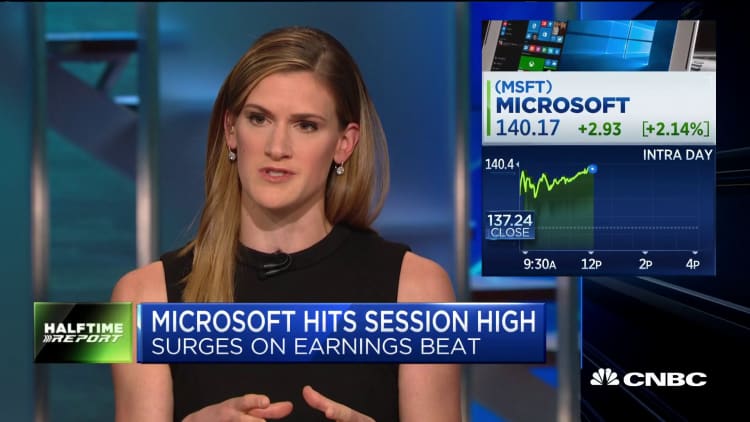Microsoft has been accused of a lot of questionable behavior in its 44-year history, including tying its web browser to its operating system to restrict rivals and publicly criticizing the capabilities of Linux open-source software to protect its Windows franchise.
Microsoft defenders will say those are the days of old. But the debate about Microsoft's tactics resurfaced this week after the company published user numbers for its Teams chat product, which competes with Slack. Specifically, Microsoft said Teams now has 20 million daily active users, compared to the 12 million users Slack claimed as of October.
Slack shares plunged 8.4% on Tuesday and closed the week at $21.17. The stock has dropped 45% since June 20, the day it debuted on the New York Stock Exchange.
With a stock market value of over $1.1 trillion and near-ubiquity in the workplace, Microsoft can package Teams with its Office 365 suite and make it really easy for its massive customer base to use. Some are speculating that Microsoft is juicing the numbers by including as active users people who boot up their computer without intentionally opening Teams.
"Microsoft Teams reaching 20 million users is complete garbage growth hacking," one Twitter user wrote on Friday.
While that sort of attack may have been expected when Bill Gates or Steve Ballmer was running the show and taking on smaller players like Netscape and Sun Microsystems, it's the kind of criticism the company has tried to avoid since Satya Nadella took over in 2014. Rather than publicly battling rivals, Nadella's approach has been to partner with them and even allow competitors' technology to run in its Azure cloud.
Jared Spataro, a corporate vice president at Microsoft, told CNBC in an email that Teams has been catching on among Microsoft's existing customers, as well as new users. He acknowledged that Teams starts by default so users can get to work more quickly, but said but that's not enough for a person to be counted in the daily active user tally.
Spataro said there are several activities that can cause a customer to be counted as a user, including making a call through Teams or starting a chat in the app. He said that Microsoft makes sure that "there's no double-counting" and added that users and IT managers can disable the automatic start-up function.
"We feel really great about the way we define daily active users," Spataro said.
A Slack representative said that to be counted as a daily active user of its service, a person on a free or paid plan has to create or consume content in the app during a 24-hour period.
Slack launched publicly in 2014 and rocketed in popularity despite a ton of competition, thanks to a modern interface and mobile-friendly approach. Microsoft came out with Teams two years later, making it part of Office 365.
Prior to that, Microsoft had spent an abundance of time and money trying to crack business messaging, a natural market for the company given the importance of its email offering. Microsoft acquired Yammer for $1.2 billion in 2012, a year after purchasing Skype for $8.5 billion, but the market remained heavily fragmented until Slack came along.
So when Microsoft announced Teams, Slack welcomed it to the market, taking out an ad in the New York Times to mark the occasion. By mid-2019, Slack took the competition seriously enough to name Microsoft as its "primary competitor" in its IPO prospectus.
Threat 'overblown'
In July, a month after Slack's public market debut, Microsoft disclosed daily active users for the first time, providing a clear comparison to Slack. The numbers suggested that Teams was bigger than Slack and growing faster.
Over the following months, Slack began raising questions about how Microsoft defines a user. Analysts have also brought up the issue.
"We continue to view the MSFT threat as overblown and debate the meaning of 'active,' especially with auto-install and auto-startup," DA Davidson analysts Rishi Jaluria and Hannah Rudoff, who have a neutral rating on Slack, wrote in a note this week, echoing the skepticism that could be found on Twitter.
Microsoft is now going all-in on Teams. The company announced in July that it will retire its Skype for Business Online service in 2021 and has been encouraging users to try out Teams.
"Our customers tell us they want to accomplish more in a single place, and to meet this need, we built Microsoft Teams as a hub for teamwork that gives teams one place for chat, meetings, calling, file collaboration and workflow," Spataro said. "This goes far beyond the capabilities offered in Skype for Business and is the next chapter of our vision for communication and collaboration."
After Microsoft gave its latest growth figures this week, Slack took another jab at its larger rival, tweeting a video showing that some of Microsoft's promotional materials look rather similar to its own.
Microsoft declined to comment on the videos.
WATCH: Valuation and overcrowding could be a risk to Microsoft, says Wilmington Trust strategist



